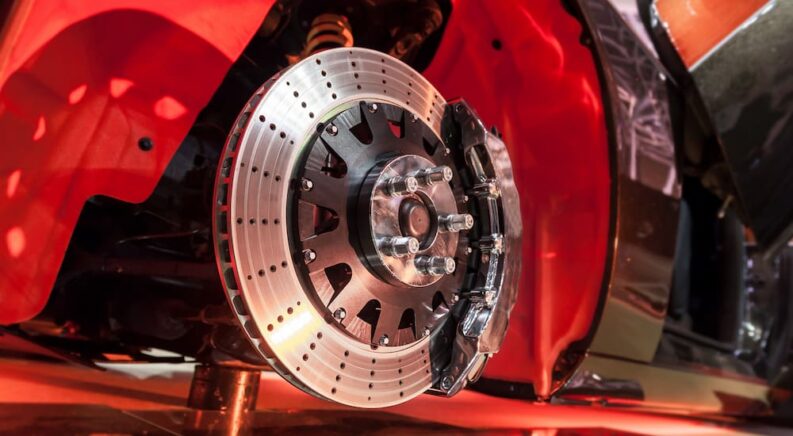If you’re anything like me, then for the longest time, what you knew about brake rotors came from early 2000s movies and video games. That meant that if you wanted a car to stop quickly, the disks absolutely needed to be gold, drilled, and, most importantly, connected to a red caliper. Then, when you got a little older, you learned about things like heat dissipation and the fact that the calipers being red doesn’t always make the car stop faster, especially if you painted them yourself.
If you’re looking for more of an overview of the basics, then check out our Brake Rotors 101 piece; today will be more of a rundown on the pros and cons of each type of rotor and what to look for in a brake system. In other words, what rotor is best for the type of driving you will be doing, whether that’s your daily commute or track days. There are plenty of misconceptions about brake cooling and what a high-performance brake setup actually looks like, and we want to help clear some of that confusion up.
Solid Rotors
Solid rotors are mostly used for rear brakes on smaller vehicles these days, and they are exactly what they sound like––single-piece rotors that are made of a solid piece of steel with no venting, etching, or drilling. They do not provide any real method of cooling due to their featureless design. They work fine for light use but will experience brake fade rather quickly with no way to keep them cooled off. Pretty much all modern vehicles have vented rotors on at least the front axle, as the front brakes do the majority of the heavy lifting during hard braking. The only real benefit of solid rotors is that their simple design makes them very cheap compared to their more expensive counterparts.

Vented Rotors
Vented rotors have no markings on the faces of the rotor, but they have hollow cavities between the two faces that allow heat to escape through the rim of the rotor. The lack of obvious markings certainly doesn’t make them look as “cool” as other setups, but vented rotors have proven to be the most efficient way of keeping brakes cool. Vented rotors also do the best job of maintaining brake pad life compared to other setups due to the smooth face and cooling capabilities. The only real downside of vented rotors is that they have no way of clearing off brake debris from the face of the rotor.

Drilled Rotors
There was once a time when rotors had to be designed to combat “outgassing,” where the heat from the friction of hard braking would cause the materials that bind the brake pads to overheat and release gas that would prevent them from gripping properly. Drilled rotors were created to combat this by allowing gasses to escape from the surface of the rotor. However, with modern brake pad technology, outgassing has become less of a problem, making drilled rotors largely obsolete.
The downside of drilled rotors is that not only do they not provide the functional benefit they were designed for anymore, but they can actually cause problems when it comes to heavy use. With extreme heat, drilled rotors can actually start cracking with the heat cycling. If you’re wondering why some companies like Porsche and Lamborghini would still use a technology that is supposedly obsolete, it’s because their rotors are not drilled but are instead forged with the holes already in place.
This is because there are benefits to having holes in the rotors when running carbon ceramic brakes or other extremely high-performance brake setups that require high heat to function properly. The holes actually make the brakes build heat faster. If you are someone who absolutely loves the look of drilled rotors and has a car that doesn’t see hard track use, you will be totally fine using drilled rotors, as long as you don’t mind the fact that they cannot be resurfaced if they develop imperfections. However, drilled rotors have little place on a modern track car if it is not running a full-carbon ceramic setup.

Slotted Rotors
Most high-end track-oriented brake kits on the market use slotted rotors. This is because slotted rotors provide the benefit of allowing gasses to escape while having a much lower risk of cracking than drilled rotors. The higher mass of slotted rotors, as opposed to drilled (or drilled and slotted) rotors, helps the rotor stay cooler for longer, which is good for non-carbon ceramic setups. Another benefit of slotted rotors is that due to the shape of the slots, they help clear off any brake debris that may build up. The downside of slotted rotors is that they cause accelerated brake pad wear due to the rough surface of the rotor. Overall, slotted rotors have the best balance of cooling capability and rotor integrity.
Two-Piece Rotors
Two-piece rotors, also known as floating rotors, have an aluminum center bell with an iron friction ring around the outside. This manner of rotor construction allows for not only reduced weight but also helps evenly distribute the heat generated by braking. Single-piece rotors do not evenly distribute heat as the surface that the pads contact gets much hotter than the center of the rotor, which can cause problems like cracking, warping, and cupping.
Two-piece rotors isolate the heat on the braking surface from the center bell, preventing this uneven heat exchange from happening. Two-piece rotor setups can be pretty pricey for the initial installation, but when it comes time for replacement, they can actually be a cost-saving measure as the aluminum bell can be reused. You only have to replace the cast iron ring that attaches to the bell. If you’re building a serious track car that you plan to use often, two-piece rotors can be a great option as they will reduce costs in the long run compared to repeatedly replacing high-performance single-piece rotors.
Run the Right Rotor for Your Ride
Overall, finding the right rotor for your use has many more factors than just which one will provide the best braking. Factors like cost and aesthetics will play a big role in which of these options is best for your vehicle. A good rule of thumb is that if you at least have vented rotors on the front axle, you’re in good shape for light track duty as long as the system is well-maintained, so don’t fret just because you don’t have the biggest and best option for your braking needs. As far as street use goes, any of the above setups will serve you just fine for commuting.

